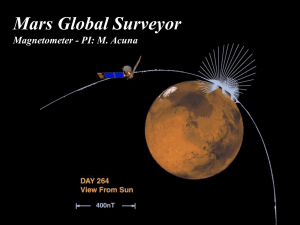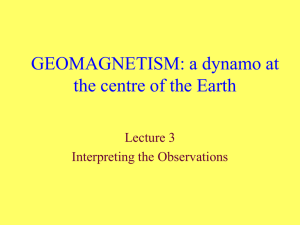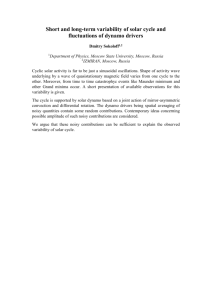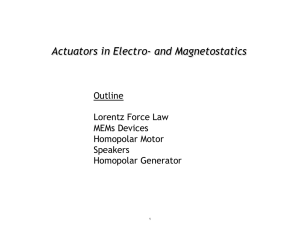Turbulent Dynamo Action
advertisement
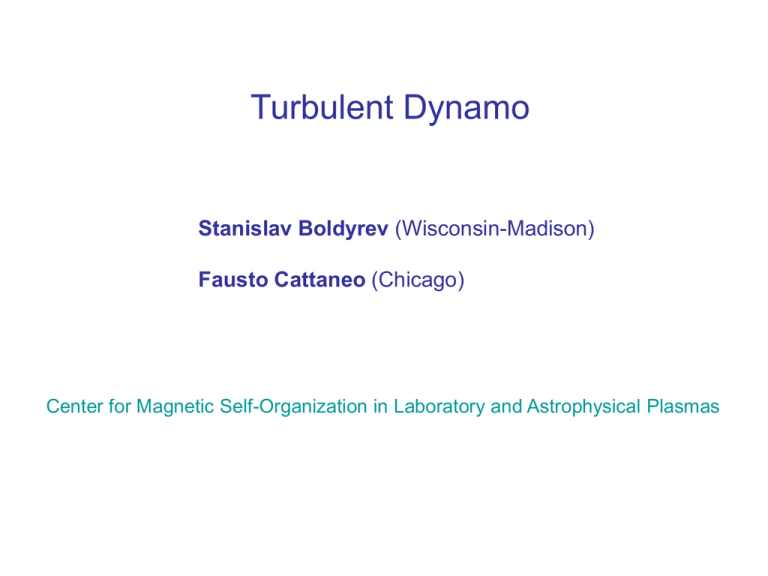
Turbulent Dynamo Stanislav Boldyrev (Wisconsin-Madison) Fausto Cattaneo (Chicago) Center for Magnetic Self-Organization in Laboratory and Astrophysical Plasmas Questions 1. Can turbulence amplify a weak magnetic field? 2. What are the scales and growth rates of magnetic fields? Kinematic Theory MHD Equations tv + (v¢r)v = -rp + (r£B)£B + v + f Kinematic dynamo tB = r£(v£B) + B Re=VL/ Rm=VL/ - Reynolds number Pm=/ - magnetic Prandtl number - magnetic Reynolds number B V1 B V2 Kinematic Turbulent Dynamo: Phenomenology V(x, t) is given. tB = r£(v£B) + B Consider turbulent velocity field V(x,t) with the spectrum: EK » 1/K K-5/3 V / 1/3 t» /V/ -2/3 smaller eddies rotate faster K0 B K K Magnetic field is most efficiently amplified by the smallest eddies in which it is frozen. The size of such eddies is defined by resistivity. Kinematic Turbulent Dynamo: Phenomenology EK Role of resistivity K-5/3 EM(K) K0 K Small Prandtl number, K K Large Prandtl number, PM´ /¿ 1 PMÀ 1 Dynamo growth rate: Dynamo growth rate: » 1/t “rough” velocity V / =1/3 » 1/t “smooth” velocity V/ K Phenomenology: Large Prandtl Number Dynamo EK K-5/3 Large Prandtl number PM=/ À 1 Interstellar and intergalactic media EM(K) K0 K K K Magnetic lines are folded B Cattaneo (1996) Schekochihin et al (2004) Phenomenology: Small Prandtl Number Dynamo EK K-5/3 EM(K) K0 K K K Small Prandtl number PM=/ ¿ 1 Stars, planets, accretion disks, liquid metal experiments V » 1/3 t » /V / 2/3 / (RM)-3/4 Dynamo growth rate: » 1/t/ (RM)1/2 [S.B. & F. Cattaneo (2004)] RM Numerics: Haugen et al (2004) Kinematic Turbulent Dynamo: Theory tB = r£(v£B) + B V(x, t) is a given turbulent field Two Major Questions: 1. What is the dynamo threshold, i.e., the critical magnetic Reynolds number RM, crit ? 2. What is the spatial structure of the growing magnetic field (characteristic scale, spectrum)? These questions cannot be answered from dimensional estimates! Kinematic Turbulent Dynamo: Theory Dynamo is a net effect of magnetic line stretching and resistive reconnection. RM > RM, crit : stretching wins, RM < RM, crit : reconnection wins, dynamo no dynamo RM=RM, crit: stretching balances reconnection: B When RM exceeds RM, crit only slightly, it takes many turnover times to amplify the field Kinematic Turbulent Dynamo: Kazantsev Model homogeneity and isotropy incompressibility No Dynamo Dynamo Kazantsev Model: Large Prandtl Number EK K-5/3 EM(K) K0 Large Prandtl number: K K K PM=/ À 1 Kazantsev model predicts: 1. Dynamo is possible; 2. EM(K)/ K3/2 Numerics agree with both results: Schekochihin et al (2004) If we know (r, t), we know growth rate and spectrum of magnetic filed Kazantsev Model: Small Prandtl Number EK K-5/3 PM=/ ¿ 1 EM(K) K0 K K K Is turbulent dynamo possible? Batchelor (1950): “analogy of magnetic field and vorticity.” No Kraichnan & Nagarajan (1967): “analogy with vorticity does not work.” ? Vainshtein & Kichatinov (1986): Yes Direct numerical simulations: (2004): No (2007): Yes resolution Small Prandtl Number: Dynamo Is Possible EK EK K-5/3 EM(K) K0 K KK PM=/ À 1 K-5/3 EM(K) K0 K K K PM=/ ¿ 1 Keep RM constant. Add small-scale eddies (increase Re). Kazantsev model: dynamo action is always possible, but for rough velocity (PM¿1) the critical magnetic Reynolds number (RM=LV/) is very large. Theory S. B. & F. Cattaneo (2004) L/ Kazantsev Model: Small Prandtl Number smooth velocity Kolmogorov (rough) velocity PMÀ 1 May be crucial for laboratory dynamo, PM¿ 1 RM, crit Simulations P. Mininni et al (2004) A. Iskakov et al (2007) PM¿ 1 Re Kinematic Dynamo with Helicity It is natural to expect that turbulence can amplify magnetic field at K ¸ K0 K-5/3 EK K0 K K K Can turbulence amplify magnetic field at K ¿ K0 ? “large-scale dynamo” Yes, if velocity field has nonzero helicity Dynamo with Helicity: Kazantsev Model h=s v¢ (r £ v)d3 x 0 given energy helicity magnetic energy magnetic helicity need to find Equations for M(r, t) and F(r, t) were derived by Vainshtein and Kichatinov (1986) Dynamo with Helicity: Kazantsev Model Two equations for magnetic energy and magnetic helicity can be written in the quantum-mechanical “spinor” form: r r h=s v¢ (r £ v)d3 x = 0 h=s v¢ (r £ v)d3 x 0 S. B. , F. Cattaneo & R. Rosner (2004) Kazantsev model and -model - model assumes scale separation r Kazantsev model, NO scale separation The - model approaches the exact solution only at r 1 Conclusions 1. Main aspects of kinematic turbulent dynamo is relatively well understood both phenomenologically and analytically. RM, crit 2. Dynamo always exists, but 1 PM 3. Separation of small- and large-scale may be not a correct procedure.
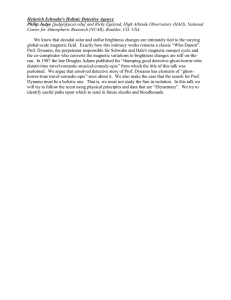
![Paul Charbonneau [], Département de Physique, Université de Montréal, Canada](http://s2.studylib.net/store/data/013086474_1-07f8fa2ff6ef903368eff7b0f14ea38f-300x300.png)
